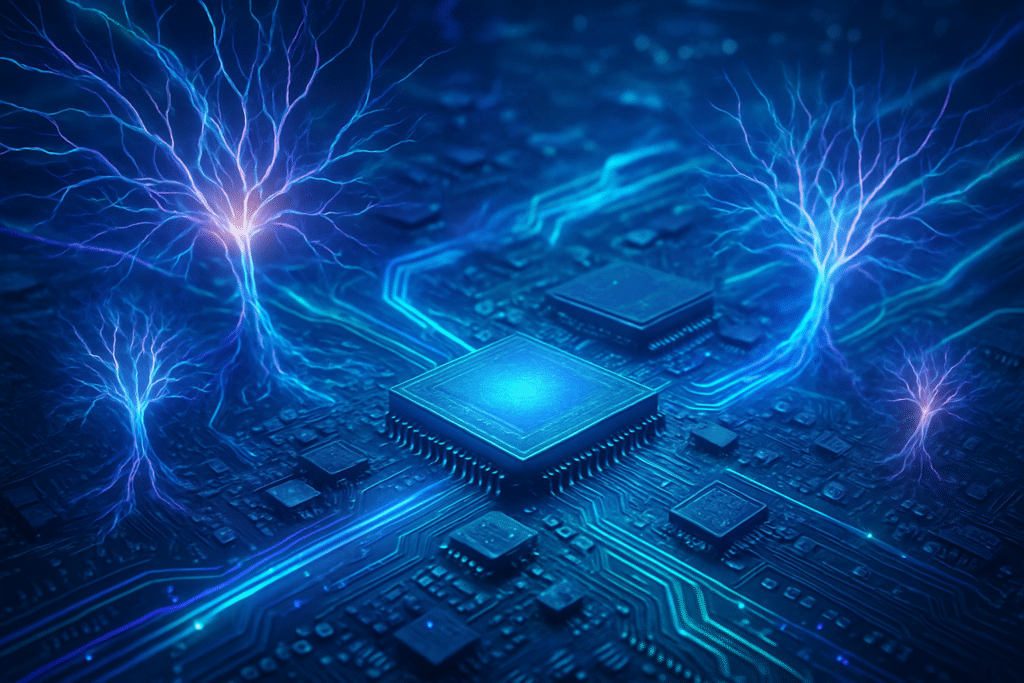
The relentless march of artificial intelligence (AI) innovation is inextricably linked to the groundbreaking advancements in semiconductor technology. Far from being a mere enabler, the relationship between these two fields is a profound symbiosis, where each breakthrough in one catalyzes exponential growth in the other. This dynamic interplay has ignited what many in the industry are calling an "AI Supercycle," a period of unprecedented innovation and economic expansion driven by the insatiable demand for computational power required by modern AI.
At the heart of this revolution lies the specialized AI chip. As AI models, particularly large language models (LLMs) and generative AI, grow in complexity and capability, their computational demands have far outstripped the efficiency of general-purpose processors. This has led to a dramatic surge in the development and deployment of purpose-built silicon – Graphics Processing Units (GPUs), Neural Processing Units (NPUs), Tensor Processing Units (TPUs), and Application-Specific Integrated Circuits (ASICs) – all meticulously engineered to accelerate the intricate matrix multiplications and parallel processing tasks that define AI workloads. Without these advanced semiconductors, the sophisticated AI systems that are rapidly transforming industries and daily life would simply not be possible, marking silicon as the fundamental bedrock of the AI-powered future.
The Engine Room: Unpacking the Technical Core of AI's Progress
The current epoch of AI innovation is underpinned by a veritable arms race in semiconductor technology, where each nanometer shrink and architectural refinement unlocks unprecedented computational capabilities. Modern AI, particularly in deep learning and generative models, demands immense parallel processing power and high-bandwidth memory, requirements that have driven a rapid evolution in chip design.
Leading the charge are Graphics Processing Units (GPUs), which have evolved far beyond their initial role in rendering visuals. NVIDIA (NASDAQ: NVDA), a titan in this space, exemplifies this with its Hopper architecture and the flagship H100 Tensor Core GPU. Built on a custom TSMC 4N process, the H100 boasts 80 billion transistors and features fourth-generation Tensor Cores specifically designed to accelerate mixed-precision calculations (FP16, BF16, and the new FP8 data types) crucial for AI. Its groundbreaking Transformer Engine, with FP8 precision, can deliver up to 9X faster training and 30X inference speedup for large language models compared to its predecessor, the A100. Complementing this is 80GB of HBM3 memory providing 3.35 TB/s of bandwidth and the high-speed NVLink interconnect, offering 900 GB/s for seamless GPU-to-GPU communication, allowing clusters of up to 256 H100s. Not to be outdone, Advanced Micro Devices (AMD) (NASDAQ: AMD) has made significant strides with its Instinct MI300X accelerator, based on the CDNA3 architecture. Fabricated using TSMC 5nm and 6nm FinFET processes, the MI300X integrates a staggering 153 billion transistors. It features 1216 matrix cores and an impressive 192GB of HBM3 memory, offering a peak bandwidth of 5.3 TB/s, a substantial advantage for fitting larger AI models directly into memory. Its Infinity Fabric 3.0 provides robust interconnectivity for multi-GPU setups.
Beyond GPUs, Neural Processing Units (NPUs) are emerging as critical components, especially for edge AI and on-device processing. These Application-Specific Integrated Circuits (ASICs) are optimized for low-power, high-efficiency inference tasks, handling operations like matrix multiplication and addition with remarkable energy efficiency. Companies like Apple (NASDAQ: AAPL) with its A-series chips, Samsung (KRX: 005930) with its Exynos, and Google (NASDAQ: GOOGL) with its Tensor chips integrate NPUs for functionalities such as real-time image processing and voice recognition directly on mobile devices. More recently, AMD's Ryzen AI 300 series processors have marked a significant milestone as the first x86 processors with an integrated NPU, pushing sophisticated AI capabilities directly to laptops and workstations. Meanwhile, Tensor Processing Units (TPUs), Google's custom-designed ASICs, continue to dominate large-scale machine learning workloads within Google Cloud. The TPU v4, for instance, offers up to 275 TFLOPS per chip and can scale into "pods" exceeding 100 petaFLOPS, leveraging specialized matrix multiplication units (MXU) and proprietary interconnects for unparalleled efficiency in TensorFlow environments.
These latest generations of AI accelerators represent a monumental leap from their predecessors. The current chips offer vastly higher Floating Point Operations Per Second (FLOPS) and Tera Operations Per Second (TOPS), particularly for the mixed-precision calculations essential for AI, dramatically accelerating training and inference. The shift to HBM3 and HBM3E from earlier HBM2e or GDDR memory types has exponentially increased memory capacity and bandwidth, crucial for accommodating the ever-growing parameter counts of modern AI models. Furthermore, advanced manufacturing processes (e.g., 5nm, 4nm) and architectural optimizations have led to significantly improved energy efficiency, a vital factor for reducing the operational costs and environmental footprint of massive AI data centers. The integration of dedicated "engines" like NVIDIA's Transformer Engine and robust interconnects (NVLink, Infinity Fabric) allows for unprecedented scalability, enabling the training of the largest and most complex AI models across thousands of interconnected chips.
The AI research community has largely embraced these advancements with enthusiasm. Researchers are particularly excited by the increased memory capacity and bandwidth, which empowers them to develop and train significantly larger and more intricate AI models, especially LLMs, without the memory constraints that previously necessitated complex workarounds. The dramatic boosts in computational speed and efficiency translate directly into faster research cycles, enabling more rapid experimentation and accelerated development of novel AI applications. Major industry players, including Microsoft Azure (NASDAQ: MSFT) and Meta Platforms (NASDAQ: META), have already begun integrating accelerators like AMD's MI300X into their AI infrastructure, signaling strong industry confidence. The emergence of strong contenders and a more competitive landscape, as evidenced by Intel's (NASDAQ: INTC) Gaudi 3, which claims to match or even outperform NVIDIA H100 in certain benchmarks, is viewed positively, fostering further innovation and driving down costs in the AI chip market. The increasing focus on open-source software stacks like AMD's ROCm and collaborations with entities like OpenAI also offers promising alternatives to proprietary ecosystems, potentially democratizing access to cutting-edge AI development.
Reshaping the AI Battleground: Corporate Strategies and Competitive Dynamics
The profound influence of advanced semiconductors is dramatically reshaping the competitive landscape for AI companies, established tech giants, and burgeoning startups alike. This era is characterized by an intensified scramble for computational supremacy, where access to cutting-edge silicon directly translates into strategic advantage and market leadership.
At the forefront of this transformation are the semiconductor manufacturers themselves. NVIDIA (NASDAQ: NVDA) remains an undisputed titan, with its H100 and upcoming Blackwell architectures serving as the indispensable backbone for much of the world's AI training and inference. Its CUDA software platform further entrenches its dominance by fostering a vast developer ecosystem. However, competition is intensifying, with Advanced Micro Devices (AMD) (NASDAQ: AMD) aggressively pushing its Instinct MI300 series, gaining traction with major cloud providers. Intel (NASDAQ: INTC), while traditionally dominant in CPUs, is also making significant plays with its Gaudi accelerators and efforts in custom chip designs. Beyond these, TSMC (Taiwan Semiconductor Manufacturing Company) (NYSE: TSM) stands as the silent giant, whose advanced fabrication capabilities (3nm, 5nm processes) are critical for producing these next-generation chips for nearly all major players, making it a linchpin of the entire AI ecosystem. Companies like Qualcomm (NASDAQ: QCOM) are also crucial, integrating AI capabilities into mobile and edge processors, while memory giants like Micron Technology (NASDAQ: MU) provide the high-bandwidth memory essential for AI workloads.
A defining trend in this competitive arena is the rapid rise of custom silicon. Tech giants are increasingly designing their own proprietary AI chips, a strategic move aimed at optimizing performance, efficiency, and cost for their specific AI-driven services, while simultaneously reducing reliance on external suppliers. Google (NASDAQ: GOOGL) was an early pioneer with its Tensor Processing Units (TPUs) for Google Cloud, tailored for TensorFlow workloads, and has since expanded to custom Arm-based CPUs like Axion. Microsoft (NASDAQ: MSFT) has introduced its Azure Maia 100 AI Accelerator for LLM training and inferencing, alongside the Azure Cobalt 100 CPU. Amazon Web Services (AWS) (NASDAQ: AMZN) has developed its own Trainium and Inferentia chips for machine learning, complementing its Graviton processors. Even Apple (NASDAQ: AAPL) continues to integrate powerful AI capabilities directly into its M-series chips for personal computing. This "in-housing" of chip design provides these companies with unparalleled control over their hardware infrastructure, enabling them to fine-tune their AI offerings and gain a significant competitive edge. OpenAI, a leading AI research organization, is also reportedly exploring developing its own custom AI chips, collaborating with companies like Broadcom (NASDAQ: AVGO) and TSMC, to reduce its dependence on external providers and secure its hardware future.
This strategic shift has profound competitive implications. For traditional chip suppliers, the rise of custom silicon by their largest customers represents a potential disruption to their market share, forcing them to innovate faster and offer more compelling, specialized solutions. For AI companies and startups, while the availability of powerful chips from NVIDIA, AMD, and Intel is crucial, the escalating costs of acquiring and operating this cutting-edge hardware can be a significant barrier. However, opportunities abound in specialized niches, novel materials, advanced packaging, and disruptive AI algorithms that can leverage existing or emerging hardware more efficiently. The intense demand for these chips also creates a complex geopolitical dynamic, with the concentration of advanced manufacturing in certain regions becoming a point of international competition and concern, leading to efforts by nations to bolster domestic chip production and supply chain resilience. Ultimately, the ability to either produce or efficiently utilize advanced semiconductors will dictate success in the accelerating AI race, influencing market positioning, product roadmaps, and the very viability of AI-centric ventures.
A New Industrial Revolution: Broad Implications and Looming Challenges
The intricate dance between advanced semiconductors and AI innovation extends far beyond technical specifications, ushering in a new industrial revolution with profound implications for the global economy, societal structures, and geopolitical stability. This symbiotic relationship is not merely enabling current AI trends; it is actively shaping their trajectory and scale.
This dynamic is particularly evident in the explosive growth of Generative AI (GenAI). Large language models, the poster children of GenAI, demand unprecedented computational power for both their training and inference phases. This insatiable appetite directly fuels the semiconductor industry, driving massive investments in data centers replete with specialized AI accelerators. Conversely, GenAI is now being deployed within the semiconductor industry itself, revolutionizing chip design, manufacturing, and supply chain management. AI-driven Electronic Design Automation (EDA) tools leverage generative models to explore billions of design configurations, optimize for power, performance, and area (PPA), and significantly accelerate development cycles. Similarly, Edge AI, which brings processing capabilities closer to the data source (e.g., autonomous vehicles, IoT devices, smart wearables), is entirely dependent on the continuous development of low-power, high-performance chips like NPUs and Systems-on-Chip (SoCs). These specialized chips enable real-time processing with minimal latency, reduced bandwidth consumption, and enhanced privacy, pushing AI capabilities directly onto devices without constant cloud reliance.
While the impacts are overwhelmingly positive in terms of accelerated innovation and economic growth—with the AI chip market alone projected to exceed $150 billion in 2025—this rapid advancement also brings significant concerns. Foremost among these is energy consumption. AI technologies are notoriously power-hungry. Data centers, the backbone of AI, are projected to consume a staggering 11-12% of the United States' total electricity by 2030, a dramatic increase from current levels. The energy footprint of AI chipmaking itself is skyrocketing, with estimates suggesting it could surpass Ireland's current total electricity consumption by 2030. This escalating demand for power, often sourced from fossil fuels in manufacturing hubs, raises serious questions about environmental sustainability and the long-term operational costs of the AI revolution.
Furthermore, the global semiconductor supply chain presents a critical vulnerability. It is a highly specialized and geographically concentrated ecosystem, with over 90% of the world's most advanced chips manufactured by a handful of companies primarily in Taiwan and South Korea. This concentration creates significant chokepoints susceptible to natural disasters, trade disputes, and geopolitical tensions. The ongoing geopolitical implications are stark; semiconductors have become strategic assets in an emerging "AI Cold War." Nations are vying for technological supremacy and self-sufficiency, leading to export controls, trade restrictions, and massive domestic investment initiatives (like the US CHIPS and Science Act). This shift towards techno-nationalism risks fragmenting the global AI development landscape, potentially increasing costs and hindering collaborative progress. Compared to previous AI milestones—from early symbolic AI and expert systems to the GPU revolution that kickstarted deep learning—the current era is unique. It's not just about hardware enabling AI; it's about AI actively shaping and accelerating the evolution of its own foundational hardware, pushing beyond traditional limits like Moore's Law through advanced packaging and novel architectures. This meta-revolution signifies an unprecedented level of technological interdependence, where AI is both the consumer and the creator of its own silicon destiny.
The Horizon Beckons: Future Developments and Uncharted Territories
The synergistic evolution of advanced semiconductors and AI is not a static phenomenon but a rapidly accelerating journey into uncharted technological territories. The coming years promise a cascade of innovations that will further blur the lines between hardware and intelligence, driving unprecedented capabilities and applications.
In the near term (1-5 years), we anticipate the widespread adoption of even more advanced process nodes, with 2nm chips expected to enter mass production by late 2025, followed by A16 (1.6nm) for data center AI and High-Performance Computing (HPC) by late 2026. This relentless miniaturization will yield chips that are not only more powerful but also significantly more energy-efficient. AI-driven Electronic Design Automation (EDA) tools will become ubiquitous, automating complex design tasks, dramatically reducing development cycles, and optimizing for power, performance, and area (PPA) in ways impossible for human engineers alone. Breakthroughs in memory technologies like HBM and GDDR7, coupled with the emergence of silicon photonics for on-chip optical communication, will address the escalating data demands and bottlenecks inherent in processing massive AI models. Furthermore, the expansion of Edge AI will see sophisticated AI capabilities integrated into an even broader array of devices, from PCs and IoT sensors to autonomous vehicles and wearable technology, demanding high-performance, low-power chips capable of real-time local processing.
Looking further ahead, the long-term outlook (beyond 5 years) is nothing short of transformative. The global semiconductor market, largely propelled by AI, is projected to reach a staggering $1 trillion by 2030 and potentially $2 trillion by 2040. A key vision for this future involves AI-designed and self-optimizing chips, where AI-driven tools create next-generation processors with minimal human intervention, culminating in fully autonomous manufacturing facilities that continuously refine fabrication for optimal yield and efficiency. Neuromorphic computing, inspired by the human brain's architecture, will aim to perform AI tasks with unparalleled energy efficiency, enabling real-time learning and adaptive processing, particularly for edge and IoT applications. While still in its nascent stages, quantum computing components are also on the horizon, promising to solve problems currently beyond the reach of classical computers and accelerate advanced AI architectures. The industry will also see a significant transition towards more prevalent 3D heterogeneous integration, where chips are stacked vertically, alongside co-packaged optics (CPO) replacing traditional electrical interconnects, offering vastly greater computational density and reduced latency.
These advancements will unlock a vast array of potential applications and use cases. Beyond revolutionizing chip design and manufacturing itself, high-performance edge AI will enable truly autonomous systems in vehicles, industrial automation, and smart cities, reducing latency and enhancing privacy. Next-generation data centers will power increasingly complex AI models, real-time language processing, and hyper-personalized AI services, driving breakthroughs in scientific discovery, drug development, climate modeling, and advanced robotics. AI will also optimize supply chains across various industries, from demand forecasting to logistics. The symbiotic relationship is poised to fundamentally transform sectors like healthcare (e.g., advanced diagnostics, personalized medicine), finance (e.g., fraud detection, algorithmic trading), energy (e.g., grid optimization), and agriculture (e.g., precision farming).
However, this ambitious future is not without its challenges. The exponential increase in power requirements for AI accelerators (from 400 watts to potentially 4,000 watts per chip in under five years) is creating a major bottleneck. Conventional air cooling is no longer sufficient, necessitating a rapid shift to advanced liquid cooling solutions and entirely new data center designs, with innovations like microfluidics becoming crucial. The sheer cost of implementing AI-driven solutions in semiconductors, coupled with the escalating capital expenditures for new fabrication facilities, presents a formidable financial hurdle, requiring trillions of dollars in investment. Technical complexity continues to mount, from shrinking transistors to balancing power, performance, and area (PPA) in intricate 3D chip designs. A persistent talent gap in both AI and semiconductor fields demands significant investment in education and training.
Experts widely agree that AI represents a "new S-curve" for the semiconductor industry, predicting a dramatic acceleration in the adoption of AI and machine learning across the entire semiconductor value chain. They foresee AI moving beyond being just a software phenomenon to actively engineering its own physical foundations, becoming a hardware architect, designer, and manufacturer, leading to chips that are not just faster but smarter. The global semiconductor market is expected to continue its robust growth, with a strong focus on efficiency, making cooling a fundamental design feature rather than an afterthought. By 2030, workloads are anticipated to shift predominantly to AI inference, favoring specialized hardware for its cost-effectiveness and energy efficiency. The synergy between quantum computing and AI is also viewed as a "mutually reinforcing power couple," poised to accelerate advancements in optimization, drug discovery, and climate modeling. The future is one of deepening interdependence, where advanced AI drives the need for more sophisticated chips, and these chips, in turn, empower AI to design and optimize its own foundational hardware, accelerating innovation at an unprecedented pace.
The Indivisible Future: A Synthesis of Silicon and Sentience
The profound and accelerating symbiosis between advanced semiconductors and artificial intelligence stands as the defining characteristic of our current technological epoch. It is a relationship of mutual dependency, where the relentless demands of AI for computational prowess drive unprecedented innovation in chip technology, and in turn, these cutting-edge semiconductors unlock ever more sophisticated and transformative AI capabilities. This feedback loop is not merely a catalyst for progress; it is the very engine of the "AI Supercycle," fundamentally reshaping industries, economies, and societies worldwide.
The key takeaway is clear: AI cannot thrive without advanced silicon, and the semiconductor industry is increasingly reliant on AI for its own innovation and efficiency. Specialized processors—GPUs, NPUs, TPUs, and ASICs—are no longer just components; they are the literal brains of modern AI, meticulously engineered for parallel processing, energy efficiency, and high-speed data handling. Simultaneously, AI is revolutionizing semiconductor design and manufacturing, with AI-driven EDA tools accelerating development cycles, optimizing layouts, and enhancing production efficiency. This marks a pivotal moment in AI history, moving beyond incremental improvements to a foundational shift where hardware and software co-evolve. It’s a leap beyond the traditional limits of Moore’s Law, driven by architectural innovations like 3D chip stacking and heterogeneous computing, enabling a democratization of AI that extends from massive cloud data centers to ubiquitous edge devices.
The long-term impact of this indivisible future will be pervasive and transformative. We can anticipate AI seamlessly integrated into nearly every facet of human life, from hyper-personalized healthcare and intelligent infrastructure to advanced scientific discovery and climate modeling. This will be fueled by continuous innovation in chip architectures (e.g., neuromorphic computing, in-memory computing) and novel materials, pushing the boundaries of what silicon can achieve. However, this future also brings critical challenges, particularly concerning the escalating energy consumption of AI and the need for sustainable solutions, as well as the imperative for resilient and diversified global semiconductor supply chains amidst rising geopolitical tensions.
In the coming weeks and months, the tech world will be abuzz with several critical developments. Watch for new generations of AI-specific chips from industry titans like NVIDIA (e.g., Blackwell platform with GB200 Superchips), AMD (e.g., Instinct MI350 series), and Intel (e.g., Panther Lake for AI PCs, Xeon 6+ for servers), alongside Google's next-gen Trillium TPUs. Strategic partnerships, such as the collaboration between OpenAI and AMD, or NVIDIA and Intel's joint efforts, will continue to reshape the competitive landscape. Keep an eye on breakthroughs in advanced packaging and integration technologies like 3D chip stacking and silicon photonics, which are crucial for enhancing performance and density. The increasing adoption of AI in chip design itself will accelerate product roadmaps, and innovations in advanced cooling solutions, such as microfluidics, will become essential as chip power densities soar. Finally, continue to monitor global policy shifts and investments in semiconductor manufacturing, as nations strive for technological sovereignty in this new AI-driven era. The fusion of silicon and sentience is not just shaping the future of AI; it is fundamentally redefining the future of technology itself.
This content is intended for informational purposes only and represents analysis of current AI developments.
TokenRing AI delivers enterprise-grade solutions for multi-agent AI workflow orchestration, AI-powered development tools, and seamless remote collaboration platforms.
For more information, visit https://www.tokenring.ai/.





